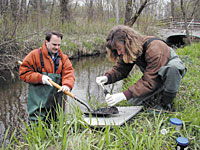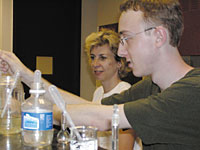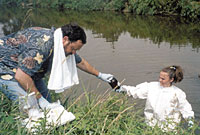|
Club program fights for clean water with buckets and test tubes
By Tom Valtin
 Brush Creek is an attractively landscaped urban waterway that runs through bustling Country Club Plaza near downtown Kansas City. On hot days, the cooling mist from a fountain in the middle of the creek provides welcome relief to joggers, picnickers, and shoppers. If only they knew... Brush Creek is an attractively landscaped urban waterway that runs through bustling Country Club Plaza near downtown Kansas City. On hot days, the cooling mist from a fountain in the middle of the creek provides welcome relief to joggers, picnickers, and shoppers. If only they knew...
"I call that thing the s-t mist-er," says Angel Kruzen, Ozark Chapter director of the Sierra Club's Water Sentinels program, which operates in seven states, with volunteers collecting water samples from "adopted" waterways and using the test results to help get them cleaned up. "Most people in the know are a little more polite; they call it the 'fecal fountain.' Whenever there's a big rain, Brush Creek absorbs so much sewer overflow that locals refer to it as 'Flush Creek.'"
Kruzen says the Missouri Department of Natural Resources (DNR) is trying to blame the fecal problem in the creek on a flock of geese that nests there. "I've studied water samples and I know exactly what's in that creek," she says. "I told the DNR I don't know of a goose that drinks coffee, wears make-up, and takes birth control pills."
Kruzen is one of eight regional staffers in the Water Sentinels program. Now in its second year, the program educates the public about local water-quality problems and the lack of environmental law enforcement. Sierra Club chapters recruit, train, and equip teams of volunteers and field them to threatened waterways, where they take regular water samples, compile evidence, and build momentum for state-level enforcement actions focused on specific watersheds.
 "I call this 'knee-deep advocacy,'" says Scott Dye, the program's Missouri-based national director. "This program helps convince regular citizens they can make a difference. Once they have scientific data to back up what they're fighting for, they can flip levers. We've got volunteers ranging from 12-year-old schoolkids to octogenarian fly fishers. There are school groups, church groups, whole families, all getting out and monitoring their site three to four times a year."
"I call this 'knee-deep advocacy,'" says Scott Dye, the program's Missouri-based national director. "This program helps convince regular citizens they can make a difference. Once they have scientific data to back up what they're fighting for, they can flip levers. We've got volunteers ranging from 12-year-old schoolkids to octogenarian fly fishers. There are school groups, church groups, whole families, all getting out and monitoring their site three to four times a year."
The Water Sentinels program has up-and-running projects in Hawaii, Illinois, Kentucky (which has two projects), Michigan, Missouri, Ohio, and Texas-with waterways ranging from pristine streams to heavily degraded Superfund sites. Club volunteers in Alabama, Indiana, Iowa, Mississippi, Nebraska, and Florida are also monitoring local waterways, but are not yet funded by the Water Sentinels program.
"There's been a tremendous volunteer response to the program," Dye says. "Once you put the word out you almost have to beat the public off with a stick."
Thirty years after passage of the Clean Water Act, water quality in the United States has improved considerably, mostly because of reduced "end-of-pipe" pollution by industrial facilities and municipal sewage treatment plants. But the U.S. EPA estimates that approximately 40 percent of the nation's waters still do not meet standards necessary to support fishing, swimming, boating, and other basic uses.
State agencies are responsible for 90 percent of all environmental law enforcement, including the Clean Water Act, but many states have been neglecting their enforcement duties. That's where the Water Sentinels come in. Volunteers collect water samples and generate scientific data on their adopted waterways with the goal of getting them cleaned up so they meet the "fishable and swimmable" conditions guaranteed by the Clean Water Act.
 Armed with test results, citizen activists put the pressure on polluters or lax regulators through public meetings, public testimony, letter-writing campaigns, and other actions. Volunteers also take their demands for clean water directly to the public, garnering media coverage of their actions and reporting on their monitoring activities. "A photo of volunteers advocating for clean water while standing in the waterway they are working to protect is a very powerful media tool," says Dye. Armed with test results, citizen activists put the pressure on polluters or lax regulators through public meetings, public testimony, letter-writing campaigns, and other actions. Volunteers also take their demands for clean water directly to the public, garnering media coverage of their actions and reporting on their monitoring activities. "A photo of volunteers advocating for clean water while standing in the waterway they are working to protect is a very powerful media tool," says Dye.
"Each project is different," he explains. "Some have fewer than a dozen volunteers, others have 150 or more. In some places the state agencies will work with you, in others they won't. Some of our people are strong on science, others are strong on organizing."
Mackinac Chapter Sentinel's director Rita Jack is strong in both. "What I want to do is marry science and advocacy," says Jack, who holds a B.S. in Resource Ecology. "The Great Lakes are 20 percent of the planet's fresh surface water-that's why I do what I do.
"I like to go out with the volunteers," she says, "so I assign myself to a team. I've got single moms, father-and- son teams, students, retirees-all sorts of people. And our volunteers have built up an excellent relationship with the Michigan Department of Environmental Quality."
Fran Caffee, Sierra Club Conservation Chair for the Valley of the Fox Group in northern Illinois, helped put the Fox River on the EPA's "impaired" list-not by polluting it, but by helping bring attention to its plight. (Impaired waterways are those that do not meet the Clean Water Act's standards for fishable and swimmable conditions.)
"There's been tremendous population growth in this area," Caffee says, "and the Fox just can't handle any more sewage treatment plants. When we started doing water monitoring here the EPA didn't consider the Fox 'impaired.' But with data provided by volunteers we were able to demonstrate that the river was degraded, and this year it was finally listed. The fight isn't over, though; now developers want to put new plants on the Fox's tributaries."
Caffee is in charge of recruiting volunteers for the Illinois Water Sentinels project on the Fox. "We run articles about the program in our quarterly newsletter," she says, "and we get a lot of local newspaper coverage, which is very helpful. A couple of times a month we'll get a call or an e-mail from someone saying they want to get involved." Caffee estimates there are now about 100 volunteers doing water monitoring on the Fox and a dozen of its tributaries.
"We supply the containers," she explains, "to make sure they're not contaminated. In most cases people take their samples from the water's edge or by dangling buckets from a bridge." The samples are then delivered to a nearby nature center, where they are lab-tested within two hours of delivery.
"A very gratifying thing about the Water Sentinels Program is that there are tangible end results," Caffee says. "And not only have we succeeded in getting waterways listed and cleaned up, we've helped form coalitions between environmental groups and state and local governments."
Another coalition has been forged in Ohio, where environmentalists have allied themselves with steelworkers at manufacturing giant AK Steel, which operates six plants around the state. Water Sentinels are working hand-in-hand with steelworkers to clean up AK's Middletown plant, where waters are so polluted that protective suits must be donned before volunteers wade in to collect their samples. Volunteers plan on testing at all AK plants where union steelworkers are employed, and they are currently training steelworkers to conduct water-quality monitoring below AK's Mansfield plant. The Water Sentinels and the steelworkers' union have also jointly released a report identifying potential threats to public health from AK's Hamilton plant.
"We're trying to fit into one another's efforts," says Susan Knight, Ohio Chapter Water Sentinels director. "Historically, there's been a perceived conflict between jobs and the environment, but thanks to alliances like this, that perception is changing."
Another alliance is being formed in rural areas. Missouri Sentinel Kruzen, who lives in the Ozark Mountains, says hunters often turn out to be among the most committed volunteers. "I've got people working with me who used to think the only good environmentalist was a dead one," she says, "and now they're really proud of their environmental credentials. One volunteer is a lifelong Republican who loves his guns, but each month he's out collecting water samples, and every week he comes to help clean up the riverbank. The other day he told me, 'Angel, I'm still a Republican, but I'm really sorry about Bush's attitude toward the environment.' Hearing things like that means a lot."
Most Water Sentinels projects are focused on rivers and creeks, but on Hawaii's Big Island, Roger Dilts, Ph.D., directs a marine-based Sentinels project. Kealakekua Bay, a marine life conservation district, is threatened by resort development and residential sprawl. One proposed development, a gated community with 125 luxury houses and a golf course, is adjacent to a state historical park. Conservationists fear the development will jeopardize the pristine waters of Kealakekua Bay, desecrate dozens of archaeological sites, and overrun historic trails.
"Environmental consultants said there would be no change to the environment," says Dilts, "but I'm skeptical because they were paid by the developers. The state is way behind in water monitoring on all the islands, and they haven't done anything on the Big Island. We're trying to get citizens out monitoring the near-coastal waters."
After the water samples are tested, Dilts reviews the data and passes it on to Reefwatchers, a local watchdog group. "Between 20 and 30 percent of the marine species living here are found nowhere else," Dilts says, "and there's been a recent decline in corals and fish populations. I believe it's due to sediment spills and non-point pollution such as cesspools. The best way to combat these threats is to show that the water quality in Kealakekua Bay is suffering."
Runoff is also creating problems in Kentucky, which has seen a rapid expansion of factory-scale chicken production. "These are huge operations," explains Lee Dew, Cumberland Chapter Sentinels director for western Kentucky. "Some have 15 or more chicken houses, each over 400 feet long with an average of 25,000 chickens per house. As a result we have literally millions of tons of accumulated manure."
Dew, who holds a Ph.D. in history, says that he "taught for about 108 years before deciding to retire and get a real job." That job was assisting his wife, Aloma, a Club conservation organizer for Kentucky. Last year, at 70, Dew took the plunge and became a Water Sentinels director.
"We do three tests a year in our watershed," he explains. "In the spring, when the farmers get their crops in, we test for herbicides and pesticides. In July, when there's high recreational use, we test for fecal content. Then in the fall we test for nutrients. We're trying to get two things: a baseline of the entire watershed, and focus studies on individual streams.
"I used to specialize in American economic history," Dew muses. "Now I specialize in livestock excreta. It's not as big a leap as you might think."

Sierra Club's Water Sentinels Program
The Clean Water Act Turns Thirty
Up to Top
|